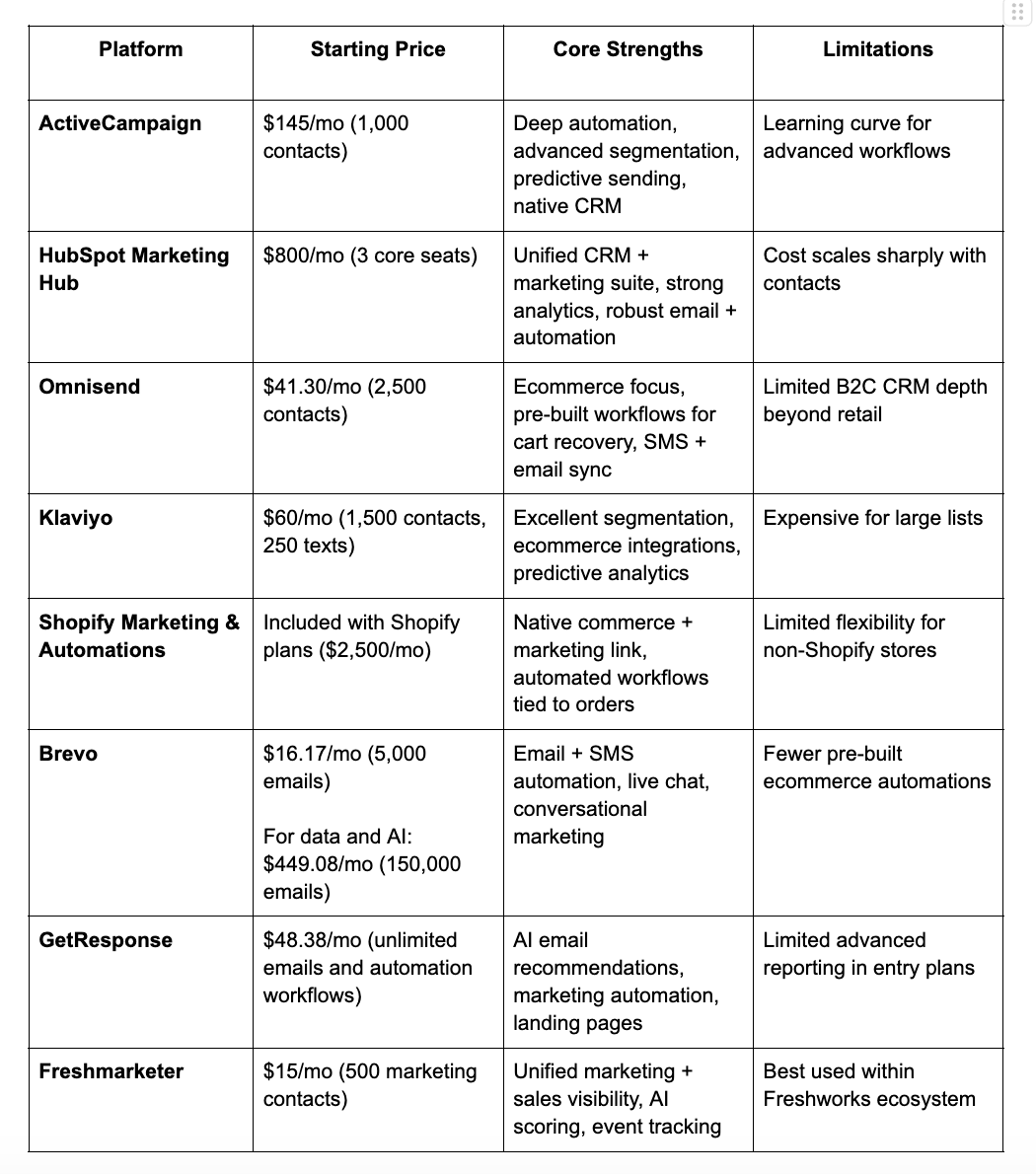Modern customers move between channels without thinking. They research on social media, check reviews on Google, browse on mobile, and make purchases based on email reminders or chat prompts. For brands, that fluid behavior introduces a problem: fragmented data and inconsistent messaging.
Omnichannel marketing platforms help fix that fragmentation, unifying data from every touchpoint (email, SMS, social, chat, web, and in-store shopping), so marketers can track journeys, personalize communication, and measure ROI in one system.
But not all platforms are created equal. Tools vary widely in integration depth, analytics accuracy, and pricing. This guide examines what defines the best omnichannel marketing platforms, how to evaluate them, and which tools perform best in real-world use.
Why Use a Leading Omnichannel Solution?
Modern marketing depends on precision, but fragmented channels and legacy attribution models make that nearly impossible. Omnichannel marketing platforms solve this by unifying data, attribution, and engagement into one continuous performance system.
1. Accurate Attribution and Smarter Spend
Traditional last-click attribution remains the dominant model, used by 65% of US and UK advertisers according to Accenture. The problem is that it only credits the final interaction before a conversion, often overlooking the dozens of earlier touchpoints that shaped it. This model relies heavily on third-party identifiers and overlooks the impact of discovery, education, and reengagement efforts.
Omnichannel systems replace that static approach with incrementality testing and multi-touch attribution. Forrester reports that incrementality testing measures the true lift or behavioral change driven by campaigns, revealing whether outcomes would have occurred without marketing intervention. That clarity allows for better budget reallocation and stronger forecasting.
2. Continuous Measurement Across Channels
Advanced frameworks like Marketing Mix Modeling (MMM) and data-driven Multi-Touch Attribution (MTA) calculate real business impact across paid, owned, and earned media.
Deloitte found that advertisers who applied MMM and MTA improved media efficiency by over 6% using the same budget, proving that better measurement — not higher spend — is what creates lift. EMarketer confirms this pattern across retail media: when measurement precision improves, underperforming channels get cut faster, while proven ones scale with higher confidence.
3. Unified Data and Real-Time Feedback
Omnichannel platforms centralize customer and campaign data across search, social, email, chat, and in-store interactions. With attribution stitched into a single feedback loop, marketers can see how each touchpoint contributes to the outcome, refine journeys in real time, and prevent waste before it compounds.
4. Higher Return on Every Marketing Dollar
The combination of unified identity, predictive attribution, and continuous optimization drives compound efficiency. Instead of relying on retrospective reporting, teams can see which actions today are most likely to impact tomorrow’s revenue.
Platform Excellence Criteria: What Defines the Best Omnichannel Marketing Solutions
The best omnichannel platforms have four characteristics in common:
1. Visibility
Visibility means knowing where and how customers engage. Platforms that excel in this area unify interaction data from every channel into a single profile, helping brands understand preferences, behaviors, and buying patterns in real time.
When each touchpoint feeds into one system, marketers can personalize messages consistently across the entire customer journey.
2. Measurement
Measurement translates visibility into actionable performance data: conversion rates, engagement levels, and customer retention across campaigns. Top systems offer real-time analytics dashboards that connect performance metrics to spend, helping you adjust your campaigns on the fly.
3. Personalization
Personalization turns customer data into relevant experiences. By connecting browsing behavior, purchase history, and communication preferences, platforms can deliver contextual messages that improve engagement and conversion. AI-driven personalization modules, like predictive send times or behavior-triggered workflows, are now standard among leading tools. Add that to your evaluation criteria.
4. Optimization
Optimization means continuous improvement through testing and iteration. This means relying on analytics feedback loops that identify which campaigns produce lift, allowing teams to redirect resources toward high-performing segments. A good platform should make that process virtually automatic.
8 Leading Omnichannel Marketing Platforms to Consider
Below is a breakdown of ten leading omnichannel marketing platforms, their features, and where each fits best.
ActiveCampaign
Best for: brands prioritizing lifecycle automation and CRM-linked personalization.
ActiveCampaign combines advanced automation with CRM functionality, making it ideal for mid-sized businesses that need data-driven orchestration across multiple touchpoints.
Users can build highly granular workflows triggered by behavior, purchase history, or predictive scoring. Its automation builder supports conditional logic and branching that rivals enterprise tools. Predictive sending adjusts message timing based on past engagement.
Limitations: complex setup and steeper learning curve for non-technical marketers.
HubSpot
Best for: teams seeking all-in-one CRM, automation, and analytics under one subscription.
HubSpot’s marketing hub integrates email, paid media, and CRM into a unified platform that connects marketing performance directly to revenue outcomes. Its attribution and contact-tracking features give full pipeline visibility, while content tools (landing pages, blogs, SEO) streamline campaign execution. HubSpot’s strength lies in its depth of analytics and ecosystem integrations — and its popularity as a CRM.
Limitations: pricing scales quickly as contact volume grows, limited flexibility for advanced customizations.
Omnisend
Best for: retail and DTC brands seeking plug-and-play ecommerce automation.
Built for ecommerce, Omnisend excels at unifying email, SMS, and push notifications into automated revenue flows. Prebuilt workflows, like cart recovery, reactivation, and post-purchase follow-up, accelerate time to value.
It integrates natively with Shopify, BigCommerce, and WooCommerce. Omnisend’s analytics dashboard tracks sales attribution and ROI per campaign, not just engagement metrics.
Limitations: lacks advanced segmentation depth for non-commerce use cases.
Klaviyo
Best for: ecommerce companies with large product catalogs and advanced personalization goals.
Klaviyo is a data powerhouse for ecommerce marketing. It builds unified customer profiles from store, web, and social data, allowing granular targeting by browsing and purchase history. Predictive analytics forecast churn, next order date, and expected value.
Dynamic content and AI-driven recommendations personalize email and SMS campaigns at scale.
Limitations: costs rise quickly with subscriber count; limited integrations outside retail platforms.
Shopify
Best for: merchants already running on Shopify who want integrated automation without extra software.
Shopify’s native marketing suite connects campaigns directly to store activity, automating engagement based on product views, orders, and repeat purchases. Users can trigger email, discount, or retargeting flows without leaving the platform.
Built-in analytics track revenue contribution per campaign and integrate seamlessly with Meta and Google Ads.
Limitations: less flexible for non-Shopify stores; limited cross-channel attribution.
Brevo
Best for: small to mid-sized businesses seeking omnichannel engagement with conversational depth.
Brevo combines email, SMS, chat, and CRM into a single workspace focused on accessibility. It includes contact scoring, A/B testing, and WhatsApp integration. Its live chat and transactional messaging features make it well-suited for service businesses that depend on real-time communication.
Brevo also offers a strong API for developers who want to embed messaging into custom apps.
Limitations: fewer ecommerce-specific automations and limited visual reporting customization.
GetResponse
Best for: content-driven marketers and educators who run subscription or course models.
GetResponse offers a full marketing suite that combines automation, webinars, and AI-powered recommendations. It’s designed for education, content, and digital product creators who need long-term nurture sequences.
Automated funnels guide users from signup to conversion, while AI modules optimize send time and content relevance. Its built-in website and landing page tools make it a strong standalone solution.
Limitations: advanced analytics and conversion tracking are only available in higher-tier plans.
Freshmarketer
Best for: service businesses and sales-led organizations already using the Freshworks suite.
Freshmarketer integrates tightly with Freshsales, offering unified visibility across marketing and sales. Its strength lies in behavioral event tracking, AI-driven lead scoring, and customer journey orchestration.
Users can view every touchpoint, from ad click to deal closure, inside one dashboard. Automation modules support both B2C and B2B lifecycles.
Limitations: best performance when used inside the Freshworks ecosystem, limited third-party integrations.

Attribution and Data Access
Most platforms offer some degree of attribution reporting, but depth varies:
- ActiveCampaign, HubSpot, and Klaviyo lead in multi-touch attribution and pipeline visibility.
- Omnisend, GetResponse, and Shopify excel in ecommerce-centric attribution (e.g., product-level ROI tracking).
Data access is fairly inconsistent. Some tools (HubSpot, Brevo) allow full API data exports, while others (Shopify Marketing) restrict export depth to protect store data. The best choice depends on your analytics stack and whether you require external BI integration with something like Tableau or Power BI.
Platform Selection Based on Business Model
Here are our picks:
- For ecommerce: Omnisend, Klaviyo, and Shopify are purpose-built for product-driven engagement.
- For content and education: ActiveCampaign and GetResponse offer dynamic content and advanced segmentation for nurture sequences.
- For service and local businesses: Brevo and Freshmarketer provide strong messaging automation and chat-driven engagement.
Platform Selection Methodology for Optimal Omnichannel Success
Selecting the right platform is a strategic decision that should balance capability, cost, and scalability against long-term data and workflow maturity. This framework (adapted from Bain’s platform strategy model) keeps your evaluation disciplined and measurable.
1. Identify
Define your marketing objectives, customer journeys, and key data flows before reviewing vendors. Clarity at this stage prevents scope creep and mismatched expectations later.
2. Build
Assess technical fit. Confirm API openness, event tracking compatibility, and identity resolution quality. Don’t forget to assess the company’s compliance posture (SOC 2, ISO 27001), uptime SLAs, and support reliability, too.
3. Seed
Pilot two or three core campaigns if you can to validate that the platform does what the seller says it does. If you can’t do that, make sure you talk to a few peers who’ve used the solution themselves and can give an honest opinion.
You should also look for the following features to keep up with advances in technology:
- Workflow complexity and data refresh cadence.
- AI capabilities, like predictive scoring, send-time optimization, and real-time experimentation.
- Cross-channel data sync and audience precision.
- Ability to support multi-region or multi-brand use without data drift.
Strategic Innovation and Future Omnichannel Opportunities: Next-Generation Customer Engagement
AI is redefining how marketers measure and manage performance. AI-driven attribution now processes thousands of data points across channels in real time, assigning credit based on behavioral probability instead of static models. The next evolution is predictive attribution: algorithms that forecast campaign impact before it happens, allowing teams to adjust spend while campaigns are live.
At the same time, digital and physical channels are converging. eMarketer projects that hybrid shopping (online research leading to in-person purchase) will dominate customer journeys. To track and optimize that behavior, brands need unified data architectures that capture every touchpoint from web search to checkout counter.
Investment patterns are shifting accordingly. Deloitte found that companies allocating more budget to marketing technology than to paid media or events achieve an 18% higher sales lift and 7% faster revenue growth. Martech-led organizations adapt faster because their systems learn faster.
Strategic Recommendations: Optimizing Omnichannel Success
Omnichannel success isn’t about deploying every feature at once. The most effective implementations follow a structured rollout:
1. Connect and Calibrate
Start by linking core systems — your CRM, ecommerce platform, email tool, and analytics software — into one shared data layer. Audit integrations for gaps in identity, attribution, and privacy compliance. Early calibration ensures accurate metrics before scale distorts them.
2. Pilot High-Impact Journeys
Select two or three customer journeys that directly affect revenue, such as onboarding or cart recovery. Automate these flows end-to-end. Measure lift in conversion and retention before expanding to other touchpoints.
3. Integrate Financial and Contextual Data
Add transaction, LTV, and churn-risk inputs into your marketing workflows. This connects engagement data to outcomes, enabling teams to allocate spend where it drives margin, not just clicks.
4. Apply Predictive and AI-Orchestrated Personalization
Deploy AI modules that test timing, messaging, and sequence variations in real time. Predictive models improve campaign ROI by learning which signals precede conversion or churn.
5. Institutionalize Optimization
Establish continuous measurement loops, like quarterly attribution reviews, performance dashboards, and automated anomaly detection. Replace campaign reviews with live data monitoring to maintain agility as channels and algorithms evolve.
Omnichannel is Your Key to Unlocking Continuous Growth
Growth doesn’t come just from stacking tools. It comes from systems that talk to each other — platforms that unify data, automate intelligently, and scale without losing precision.
The right omnichannel marketing platform can turn every interaction into input for smarter decisions and sustained growth.
Thinking about new ways to engage your audiences?
Check out Kard, the first independent commerce media network that uses predictive AI and first-party transaction data to deliver hyperpersonalized rewards. Sign up for a demo today.
Frequently Asked Questions About Best Omnichannel Marketing Platforms
What is an omnichannel marketing platform?
An omnichannel marketing platform is software that connects every customer touchpoint (email, SMS, web, chat, and social) into a single data and automation system. It helps marketers manage campaigns across channels while maintaining consistent messaging and tracking engagement in one place.
How does an omnichannel platform differ from multichannel marketing?
Multichannel means a brand appears across many platforms. Omnichannel means those platforms are connected. Customer data, preferences, and interactions are shared in real time, ensuring a consistent experience across all customer engagement channels.
Why is unified data important for omnichannel success?
Without unified data, teams can’t personalize accurately or measure ROI. A central customer data layer eliminates blind spots between marketing automation, ecommerce, and CRM systems, linking activity to outcomes.
What are the four C’s of omnichannel marketing?
Consistency, context, convenience, and continuity. Together, they define how customers experience the brand across every interaction.
Which platforms offer the best value for small businesses?
Brevo and Omnisend offer affordable entry plans with strong automation and chat integration for under $30 per month.
Which platforms are best for ecommerce brands?
Klaviyo, Shopify, and Omnisend stand out for deep product data integration, cart recovery workflows, and revenue attribution tied directly to store activity.
What platform suits content and education-based businesses?
ActiveCampaign and GetResponse both support long nurture sequences, behavioral tagging, and advanced segmentation for courses, newsletters, and subscription models.
How do these tools measure ROI?
They track campaign influence on conversions, average order value, and customer lifetime value through multi-touch attribution and transaction-based analytics.
Can omnichannel platforms integrate with financial systems?
Yes. Many integrate directly with Stripe, QuickBooks, or PayPal APIs to trigger campaigns when invoices, payments, or revenue thresholds change.
How do AI and automation fit in?
AI helps predict send times, segment audiences, and personalize messaging. Automation executes campaigns at scale, ensuring consistency across channels.
What’s the biggest mistake brands make when adopting omnichannel?
Rushing to deploy every feature before data systems are unified. Start small, test attribution accuracy, and expand once reporting is stable.
How long does implementation take?
Small setups can launch in weeks. Larger rollouts with CRM and ecommerce integration may take two to three months, depending on data complexity.
How do you measure success after implementation?
Monitor retention rates, conversion lift, and LTV/CAC ratio. Use these benchmarks to refine automation and creative strategy.
What’s next for omnichannel marketing platforms?
AI-driven attribution and predictive personalization will make campaigns more adaptive, turning today’s automation into tomorrow’s autonomous marketing systems.


